The Legacy of Women at Presbyterian College
June 2008
When Presbyterian College was founded in 1880, it was open to women as well as men. According to the catalog, “young ladies are entered in the same classes and upon the same footing, except that in their case, the classical studies are optional.” Female students were not, however, permitted to live on campus. They were either local women or made arrangements to board with families in town. The college’s first graduating class, in 1883, consisted entirely of women, including Dr. Jacobs’ daughter, Florence. According to the 1888 college catalog, the presence of young women on the campus “has in no way proved detrimental to the scholarly work of the Institution, and has materially lessened difficulties of discipline.”
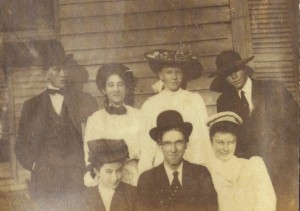
The PC crowd
According to Fronde Kennedy, who graduated in 1896, the college took no responsibility for the co-eds when they were not on the campus. However, while on campus, “they were carefully chaperoned, being required to spend their free hours under the eye of a professor – an arrangement equally distasteful to both parties.” Among the social activities were parties in local homes, dancing (not, however, on the campus – dances were held in Copeland Hall, in downtown Clinton), swimming in the Enoree River, picnics, hikes, and fraternity banquets. Co-eds did not engage in sports, except for recreational tennis on the college tennis court. They, of course, attended other games, including baseball, where, in the absence of stands, they “sat in chairs brought from the mess hall by devoted swains.”
In the early years, there were very few female students at PC, with only 11 in 1915 and 21 in 1918. Indeed, the College’s slogan in those days was “Where men are made.” For a time, between 1921 and 1931, no women were admitted to the college, because the Synod of South Carolina wished to bolster enrollment at Chicora College, its women’s college in Columbia. When Chicora merged with Queens in Charlotte in 1932, women day students were once again welcome at PC.
One woman student from this period described some of her experiences in the college magazine in 1932. Although her experience as a co-ed at PC was a positive one, apparently the co-eds had to make some adjustments in the classroom. “At the beginning of the year, we took seriously the masculine idea that boys know more than girls; we listened attentively when they opened to us their spacious minds. But it didn’t take us long to realize that masculine knowledge is a mostly masculine bluff. Now we listen demurely and allow them to get what satisfaction they can from telling us things that we already know.”
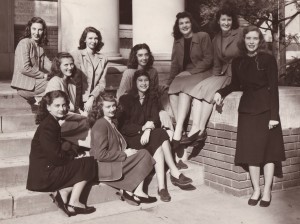
Women of APD
There were still not many social activities for women. A local sorority, Alpha Psi Delta, was organized in 1933. Otherwise, women were involved in campus organizations only as “sponsors” – women, sometimes girlfriends, sometimes even mothers and children, who were chosen by the organization to represent them. Aside from a short-lived women’s basketball team in the 1930s, there were no women’s sports except intramurals until 1974, when the varsity tennis team was organized.
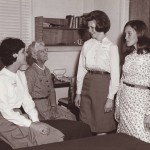
Mrs. Beach and
coedsin Clinton Hall, c. 1965
In the 1950s, the Synod of South Carolina began to discuss making PC fully co-educational. The first step in this process was the opening of Calvert House, a house on Calvert Avenue which housed 14 students and was supervised by a faculty family that lived on the first floor. Full co-education arrived in 1965 when Clinton Hall was opened. In a truly amazing article in The State in October of 1965, the reporter noted that “Girl-Watching is now one of the favorite sports at Presbyterian college, with the advent this fall of full co-education.” Included was a picture of three male students sitting on the steps, “absorbed in their work.” Apparently, male students were terribly distracted during meals and study time but appreciated the fact that they didn’t have to travel 60 or 70 miles to date girls from nearby colleges. By 1966, Clinton Hall was almost full, with 118 women, who made up 17% of the student body.
The rules for these new students were quite different than those today. Clinton Hall was supervised by a housemother. There was a curfew, and coeds were required to sign out of the dorm any time they planned to be out after 7 p.m., or any time they planned an out-of-town trip. “Anyone leaving the campus after 7:00 in the evening must be accompanied by a date, an adult, or another student.” Parental permission was required for overnight trips. No men were permitted in the living areas of the dorm, and a dress code required skirts or dresses except for PE class.
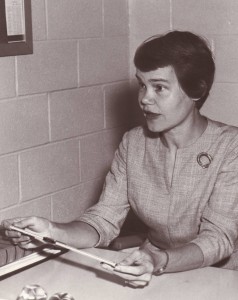
Eugenia Carter, PC’s first woman instructor
Women were also added to the faculty and Board of Trustees. Eugenia Carter, who had been teaching in the science department since 1958, was joined by 5 women professors in 1967. In 1968, Mrs. J.B. Fuqua of Atlanta and Dr. Virginia S. Hardie of Clemson were added to the Board. By 1973, PC had its first female student body president, Ginny Nichols.
The number of women students continued to grow – by 1968-69, they made up 21.4% of the student body, 222 students. This was the year that Bailey Hall was turned into a women’s dorm to house the overflow. By 1975, when Mary Erwin Belk Hall was added, there were 358 women on campus, comprising 39% of the student body. There were also more activities for women students. In 1981, Martha Anne Green started Women’s Social Hall, a campus-wide organization for women. In 1989, national sororities were permitted on campus for the first time, and Alpha Delta Pi, Zeta Tau Alpha, and Sigma Sigma Sigma were organized.
The percentage of women students gradually increased, until it reached 48% in 1990-91. Women continued to be housed in Clinton, Bailey, and Belk. The following year, Grotnes and Barron were added as women’s residences, as were three houses on Calhoun Street. By the fall of 1993, women made up 50% of PC’s student body; since that year, they have surpassed 50% in all but two years, reaching a peak of 56% in 2001-2002. Additional facilities that have been opened to women over the years include the townhouses, Laurens, Smyth, Carol International House, the Scottish Arms, and the Senior Hall.
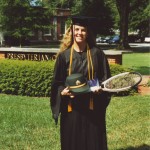
Kimberly Hampton ’98
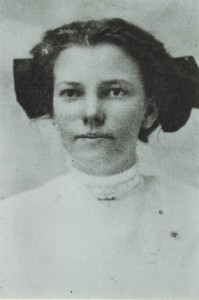
Prominent women who have graduated from PC include Anne Austin Young (1910), pioneering SC doctor; Ann Eliza Hatton Lewis, (1922) founder of Georgia Magazine; Mary Ella Williams Osman (1938), journalist and senior editor of Architecture; Julie Johnson Weatherly (1983), lawyer and nationally recognized expert on school law and special education cases; Joan Standridge Gray (1973), current moderator of the PC(USA); Capt. Kimberly Hampton (1998), helicopter pilot, killed in Iraq in January of 2004.
